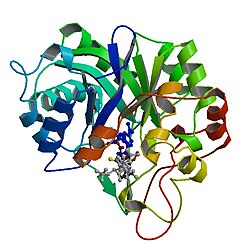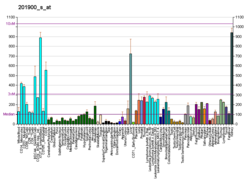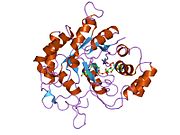
4-Hydroxynonenal, or 4-hydroxy-2E-nonenal or 4-hydroxy-2-nonenal or 4-HNE or HNE,, is an α,β-unsaturated hydroxyalkenal that is produced by lipid peroxidation in cells. 4-HNE is the primary α,β-unsaturated hydroxyalkenal formed in this process. It is a colorless oil. It is found throughout animal tissues, and in higher quantities during oxidative stress due to the increase in the lipid peroxidation chain reaction, due to the increase in stress events. 4-HNE has been hypothesized to play a key role in cell signal transduction, in a variety of pathways from cell cycle events to cellular adhesion.
Carboxy-lyases, also known as decarboxylases, are carbon–carbon lyases that add or remove a carboxyl group from organic compounds. These enzymes catalyze the decarboxylation of amino acids, beta-keto acids and alpha-keto acids.

In enzymology, aldose reductase is a cytosolic NADPH-dependent oxidoreductase that catalyzes the reduction of a variety of aldehydes and carbonyls, including monosaccharides. It is primarily known for catalyzing the reduction of glucose to sorbitol, the first step in polyol pathway of glucose metabolism.

In enzymology, a 3-hydroxyacyl-CoA dehydrogenase (EC 1.1.1.35) is an enzyme that catalyzes the chemical reaction

Aldo-keto reductase family 1, member B1 (AKR1B1), also known as aldose reductase, is an enzyme that is encoded by the AKR1B1 gene in humans. It is a reduced nicotinamide-adenine dinucleotide phosphate (NADPH)-dependent enzyme catalyzing the reduction of various aldehydes and ketones to the corresponding alcohol. The involvement of AKR1B1 in oxidative stress diseases, cell signal transduction, and cell proliferation process endows AKR1B1 with potential as a therapeutic target.

Aldo-keto reductase family 1 member C3 (AKR1C3), also known as 17β-hydroxysteroid dehydrogenase type 5 or 3α-hydroxysteroid dehydrogenase type 2 (3α-HSD2) is a key steroidogenic enzyme that in humans is encoded by the AKR1C3 gene.

Aldo-keto reductase family 1 member C1 also known as 20α-hydroxysteroid dehydrogenase, 3α-hydroxysteroid dehydrogenase, and dihydrodiol dehydrogenase 1/2 is an enzyme that in humans is encoded by the AKR1C1 gene.

Carbonyl reductase 1, also known as CBR1, is an enzyme which in humans is encoded by the CBR1 gene. The protein encoded by this gene belongs to the short-chain dehydrogenases/reductases (SDR) family, which function as NADPH-dependent oxidoreductases having wide specificity for carbonyl compounds, such as quinones, prostaglandins, and various xenobiotics. Alternatively spliced transcript variants have been found for this gene.

Adrenodoxin reductase, was first isolated from bovine adrenal cortex where it functions as the first enzyme in the mitochondrial P450 systems that catalyze essential steps in steroid hormone biosynthesis. Examination of complete genome sequences revealed that adrenodoxin reductase gene is present in most metazoans and prokaryotes.

3α-Hydroxysteroid dehydrogenase type 1 (3α-HSD1) or aldo-keto reductase family 1 member C4 is an enzyme that in humans is encoded by the AKR1C4 gene. It is known to be necessary for the synthesis of the endogenous neurosteroids allopregnanolone, THDOC, and 3α-androstanediol. It is also known to catalyze the reversible conversion of 3α-androstanediol (5α-androstane-3α,17β-diol) to dihydrotestosterone and vice versa.

Aldo-keto reductase family 1 member B10 is an enzyme that in humans is encoded by the AKR1B10 gene.

Aflatoxin B1 aldehyde reductase member 2 is an enzyme that in humans is encoded by the AKR7A2 gene.

The aldo-keto reductase family is a family of proteins that are subdivided into 16 categories; these include a number of related monomeric NADPH-dependent oxidoreductases, such as aldehyde reductase, aldose reductase, prostaglandin F synthase, xylose reductase, rho crystallin, and many others.

Alrestatin is an inhibitor of aldose reductase, an enzyme involved in the pathogenesis of complications of diabetes mellitus, including diabetic neuropathy.
5β-Reductase, or Δ4-3-oxosteroid 5β-reductase (EC 1.3.1.3, 3-oxo-Δ4-steroid 5β-reductase, androstenedione 5β-reductase, cholestenone 5β-reductase, cortisone 5β-reductase, cortisone Δ4-5β-reductase, steroid 5β-reductase, testosterone 5β-reductase, Δ4-3-ketosteroid 5β-reductase, Δ4-5β-reductase, Δ4-hydrogenase, 4,5β-dihydrocortisone:NADP+ Δ4-oxidoreductase, 3-oxo-5β-steroid:NADP+ Δ4-oxidoreductase) is an enzyme with systematic name 5β-cholestan-3-one:NADP+ 4,5-oxidoreductase. This enzyme catalyses the following chemical reaction
FMN reductase (NADH) (EC 1.5.1.42, NADH-FMN reductase) is an enzyme with systematic name FMNH2:NAD+ oxidoreductase. This enzyme catalyses the following chemical reaction
Peptide-methionine (S)-S-oxide reductase (EC 1.8.4.11, MsrA, methionine sulphoxide reductase A, methionine S-oxide reductase (S-form oxidizing), methionine sulfoxide reductase A, peptide methionine sulfoxide reductase, formerly protein-methionine-S-oxide reductase) is an enzyme with systematic name peptide-L-methionine:thioredoxin-disulfide S-oxidoreductase (L-methionine (S)-S-oxide-forming). This enzyme catalyses the following chemical reaction
Taurochenodeoxycholate 6alpha-hydroxylase (EC 1.14.13.97, CYP3A4, CYP4A21, taurochenodeoxycholate 6alpha-monooxygenase) is an enzyme with systematic name taurochenodeoxycholate,NADPH:oxygen oxidoreductase (6alpha-hydroxylating). This enzyme catalyses the following chemical reaction

Aldo-keto reductase family 1 member C2, also known as bile acid binding protein, 3α-hydroxysteroid dehydrogenase type 3 (3α-HSD3), and dihydrodiol dehydrogenase type 2, is an enzyme that in humans is encoded by the AKR1C2 gene.
In enzymology, a prostaglandin-F synthase (PGFS; EC 1.1.1.188) is an enzyme that catalyzes the chemical reaction:





















